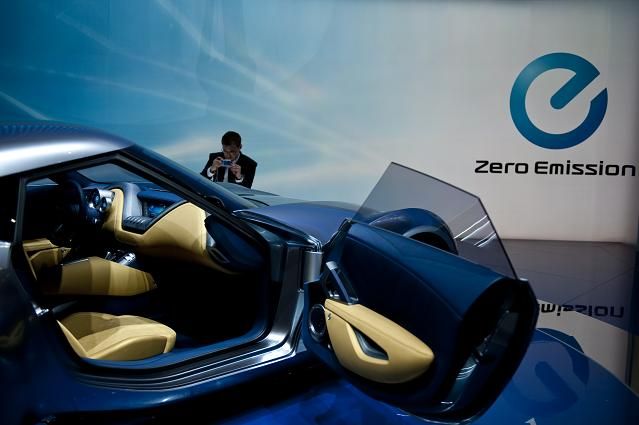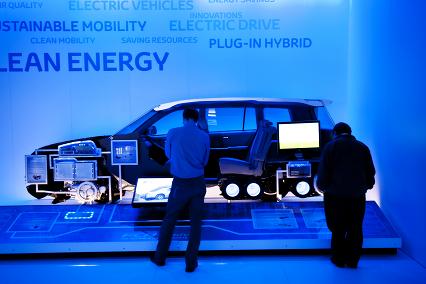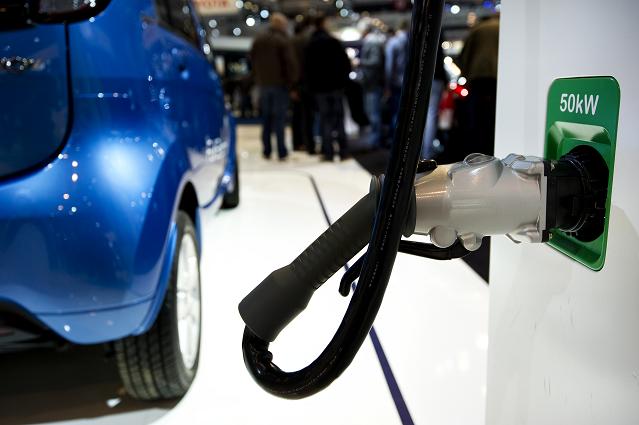Sustainability in the automobile industry
Climate Action spoke to Erik Jonnaert, Secretary General of the European Automobile Manufacturers' Association (ACEA), about sustainability and emissions reduction in the automobile industry.

The European Automobile Manufacturers' Association (ACEA) represents leading car, van, truck and bus makers and works with a variety of institutional, non-governmental, research and civil society partners to address the global challenges of mobility, sustainability and competitiveness.
Climate Action spoke to Erik Jonnaert, Secretary General of ACEA, about sustainability and emissions reduction in the automobile industry.
Can tell us a bit more about ACEA and how it works with partners to achieve environmental and social sustainability of the automobile industry?
ACEA brings together Europe’s 15 leading manufacturers of cars, trucks and buses, all global players with manufacturing operations on the continent. Its mission is to engage in dialogue with both policy makers and other stakeholders, to constructively contribute to the creation of a regulatory and legislative environment in Europe which enables innovation and sustainable growth for the automotive industry.
The automotive industry is one of the most regulated sectors in Europe. This regulatory framework consists of around 80 EU Directives and over 70 international UNECE regulatory agreements, mostly covering technical issues and standardisation. Its large footprint means that it necessarily has to work with a wide range of stakeholders from within the legislative process – such as the EU institutions, business sectors, and civil society actors.
Acting as a portal for expert knowledge on vehicle-related regulation, ACEA communicates the role and importance of the industry, monitors activities that affect the automobile industry, and undertakes strategic reflection on the increasingly global challenges of mobility, sustainability and competitiveness.

The revision of the Directive on the weights and dimensions of commercial vehicles provides a unique opportunity to reduce CO2 emissions more efficiently from heavy duty vehicles. It will allow for more space, which better incorporates the latest technologies for improving fuel efficiency and reducing CO2 emissions. ACEA supports having additional space for fuel-efficient innovations in trucks, calling for the flexibility to use the extra space for innovations that have the greatest impact on fuel efficiency.
This does not only include aerodynamics (the best trucks on the market today would only gain a 1 per cent fuel-efficiency improvement through aerodynamic cabs), but include a number of technological innovations that require more space, such as updated and alternative powertrains, more energy-efficient cooling solutions, improved airflow around the engine, fuel tanks for alternative fuels and waste heat recovery.
ACEA’s ... board members presented how they believe the annual potential reduction in CO2 emissions could be doubled
This flexible approach has more potential to improve the fuel efficiency of the truck of the future.
In 2008, ACEA’s commercial vehicle manufacturers committed to an agenda called ‘Vision 20-20’. This aims to reduce the fuel consumption of commercial vehicles by 20 per cent by the year 2020 compared to 2005. This is equivalent to an annual 1.3 per cent improvement in fuel economy, with commiserate reductions in CO2 emissions. This is in addition to the 60 per cent improvement already achieved in vehicle efficiency performance since 1965.
However, the industry is well aware than more can be achieved, particularly if measures could be rolled out to the entire fleet, which at the moment stands at around 34 million commercial vehicles in the EU. This is why at the ACEA press summit at the IAA in Hannover, held on 23 September at the IAA commercial vehicles fair in Hannover, ACEA’s commercial vehicle board members presented how they believe the annual potential reduction in CO2 emissions could be doubled through greater cooperation with all stakeholders.
Based on a new report by independent research body Transport and Mobility Leuven (TML), a 3.5 per cent annual reduction rate could potentially be achieved. Data from the new TML study quantify for the first time the potential of such an integrated approach for the period 2014-2020 as follows: 6 per cent reduction for vehicle-related measures across the entire fleet; 2.5 per cent reduction through alternative fuels; and 13 per cent reduction through operations. This translates into a more than 20 per cent cut in CO2 emissions from the road transport sector over the next six years, or an annual reduction rate of 3.5 per cent.
It is the hope of the commercial vehicles industry that by applying a more coordinated and integrated approach Europe’s freight transport sector could do even more to contribute to reducing CO2 emissions across Europe and the world.
The European Commission unveiled its strategy for CO2 emissions from trucks and buses in May. Can you tell us more about how the strategy will impact Europe’s commercial vehicle industry?
The European commercial vehicle industry welcomes the introduction of a certification system which would give customers full transparency on fuel efficiency.
Fuel efficiency is a top priority for the transport companies who buy and use trucks and buses, because fuel accounts for over one-third of their total operating costs. Fuel efficiency is therefore the number one competitive factor in developing and selling heavy-duty vehicles.
This certification system once deployed will also allow both policy makers as well as industry to have a consistent database of CO2 emission data which will become a useful reference for benchmarking and measuring progress.
Fuel efficiency is the number one factor in developing and selling heavy-duty vehicles
European commercial vehicle manufacturers are world leaders in fuel efficiency, with fuel consumption down 60 per cent since 1965, thanks to technologies like common rail injection, automated gearboxes, turbocharging and intercooling. In working to further reducing emissions, the industry advocates an integrated approach. Enhanced vehicle technologies must be accompanied by other measures if environmental targets are to be met: training in eco-driving, adjustments in vehicle dimensions, improved transport logistics, better and more intelligent infrastructure, a shift to alternative fuels and so on.
According to a major study from the ACEA and its partners, established battery applications should be replaced with alternative technologies to help meet energy efficiency targets. Can you tell us more about the reports’ conclusions?
The recent report on battery technologies released by EuroBAT, with support from ACEA and related stakeholders, demonstrated that specific battery technologies have specific uses, many of which are already served and will continue to be so for the foreseeable future.
For example, common lead-acid batteries, mostly used for ignition and basic system operation in standard internal combustion engine vehicle applications, are still the most effective means for their intended purpose due to their versatility and deep cycle resistance. This is expected to be the case for the foreseeable future. 95 per cent of lead-acid batteries are taken back and recycled by battery manufacturers in a closed-loop system, generating new batteries from secondary lead, making them a relatively environmentally friendly solution.
Electric vehicles operate with an electrical storage system of at least 15kWh. Due to the need for high energy density, this segment is currently dominated by high-voltage lithium-ion battery systems, due to their superior energy density, fast recharge capability and high discharge power.
As in the case of hybrid vehicles, an auxiliary 12V lead-based battery is still additionally required in plug-in hybrid electric vehicles (PHEVs) and electric vehicles, in order to supply all non-propulsion electrical components, including safety-relevant features, with charge.
For commercial applications, harsh environments and heavy applications, sodium-nickel chloride batteries are a competitive option. Nickel-metal hydride batteries have been used in certain PHEVs in the past, but are gradually being superseded by lithium-ion batteries across this segment, which continue to decrease in cost. The high weight and lower capacity turnover of lead-based batteries limits their use in both PHEVs and EVs, with their corresponding energy density too low to match the requirements of vehicle manufacturers.
"95 per cent of lead-acid batteries are taken back and recycled"
This situation is not expected to change, with research and innovation efforts focussing on improving the competitiveness of lithium-ion and sodium nickel chloride technology, or on developing entirely new battery concepts.
Significant research efforts are directed towards the further development of electric vehicle battery systems, which must meet consumer demands for lower costs and longer vehicle driving ranges. European industry is also continuing to improve the performance of 12V automotive batteries in order to meet the power requirements of new micro-hybrid systems.
In the far future, other novel battery technologies (e.g. zinc-air, lithium-sulphur, lithium-air) may become competitive for use in electric vehicles, and can theoretically deliver higher energy densities than lithium-ion chemistries are capable of. However, these technologies are still in early phases of development, and so are not focussed upon in this report.
What are the main inhibitors to electric vehicles being taken up more widely across Europe and how are these being overcome?
The automobile industry is competing to offer attractive electrically chargeable vehicles, ECVs, while maintaining high safety and comfort standards. One among many major challenges is reducing the cost of the vehicle (in particular of the battery system).
Electrically Chargeable Vehicles (ECV), include all types of electric vehicle, including Plug-in Hybrids and Extended-Range Electric Vehicles (EREV). Take-up is growing from a low base. Sales were around 28,250 for full-year 2012 in the EU. Full year figures for 2013 were 55,881 for all types of ECV in the EU. Of these, pure battery electric vehicles made up about half of the total: 24,400 in 2013, up from 14,500 in 2012. The remaining 31,477 is made up of PHEV and EREVs. Sales for 2014 are expected to be higher, though it is still difficult to quantify exactly the magnitude of the rise in sales
Current ECV sales figures equate to a market share of about 0.5 per cent. In the long run ACEA expects EV registrations make up between 2-8 per cent of total sales by 2025.
The estimated growth rate is based on a number of factors, ranging from the technological to consumer and infrastructure-based.
Customers will have to get used to some specific characteristics of the new technologies such as different driving or recharging requirements. The education and information of customers will have to involve all players concerned.
The energy sector will have to build a suitable recharging infrastructure, as this will be the prerequisite for customers’ acceptance of electrically chargeable vehicles.
National governments need to provide appropriate market incentives, particularly during the introduction phase of this new technology in the market. New technologies generally first come in low volumes and at a significant cost premium, and this needs to be offset by a positive policy framework.
Standardisation bodies and the industry need to agree quickly on standards and common interfaces (e.g. vehicle-to-grid infrastructure) to avoid a fragmented pattern of locally competing and incompatible solutions. The goal must be to establish EU-wide standards, and if possible, worldwide.
BMW’s i series of electric and hybrid vehicles is helping to change the face of the market automobile industry? What regions and markets are most open and proactive in the uptake of clean vehicles?
The shape of the market varies wildly across the world. The total fleet of electric vehicles globally is now around 400,000 according to the Centre for Solar Energy and Hydrogen Research Baden-Württemberg (Zentrum für Sonnenenergie- und Wasserstoff-Forschung Baden-Württemberg), but sales are not uniform. In Norway and the Netherlands, forms of electric vehicle (PHEV or BEV) make up as much as 6 per cent of total sales. However, overall, only 5 countries globally are seeing a market share of more than 1 per cent for this type of vehicle in the first half of 2014.








